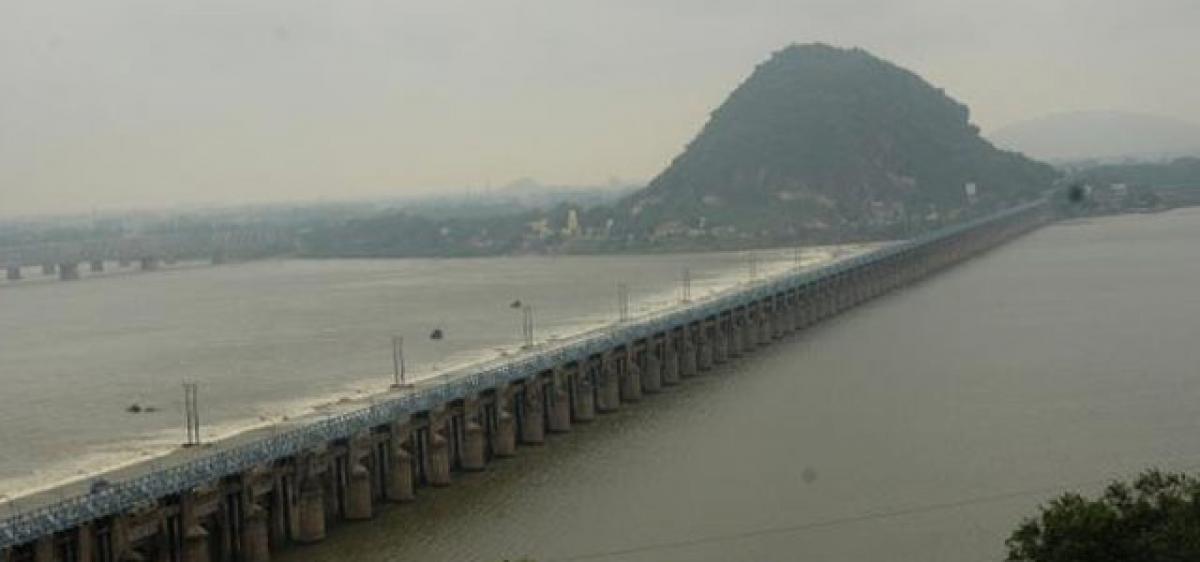Live
- Direct flights from Rajahmundry to major cities soon
- Search intensified for Gowtham Reddy as HC dismisses his bail plea
- Santosh Trophy final round to begin in Hyderabad tomorrow
- BGT: Rohit must return to opening for Brisbane Test, says Ponting
- Swimming sensation Havya steals the show
- NDTL gets WADA nod to manage Athlete Biological Passport
- BWF World Tour Finals: Treesa-Gayatri wins 2nd match to keep semis hopes alive
- Youngest ever to conquer chess world
- Jamie Lever to star in Lakshmi R Iyer’s ‘2050’: It challenged me emotionally
- Prateeksha Srivastava says she seldom meets fellow music composers Rusha, Blizza, in person
Just In

With an aim to storage adequate drinking water to new capital city Amaravati and promote riverfront tourism, the state government has decided to construct two barrages and two anicuts upstream and downstream Prakasam Barrage.
Government plans two anicuts downstream Prakasam Barrage as part of riverfront tourism
Vijayawada: With an aim to storage adequate drinking water to new capital city Amaravati and promote riverfront tourism, the state government has decided to construct two barrages and two anicuts upstream and downstream Prakasam Barrage.
Chief Minister N Chandrababu Naidu has reportedly of the view to develop tourism spots both sides of the Prakasam Barrage and take up beautification of the area downstream till Ramalingeswara Nagar.
Sources in the Irrigation department said rubber dams at Ramalingeswara Nagar and Yanamalakuduru, has been proposed to store around 0.2 tmcft of water at each structure.
A beautiful river view will appear to tourists when they stand at the barrage if these two proposed projects are materialised. It is also proposed to develop boating activity till Ramalingeswara Nagar in the Krishna River as part of riverfront tourism.
The rubber dams will also enable to maintain minimum water level in the river and divert to some other irrigation structures. These two are in addition to the proposed barrages at Vykuntapuram village upstream Prakasam Barrage and Oleru village downstream Prakasam Barrage.
It is proposed to store around 7-8 tmcft of water at Vykuntapuram and 1.7 tmcft of water at Oleru barrage.
In a report to the government, an experts committee said the barrage at Vykuntapuram downstream Muniyeru river confluence will be a viable option instead of two barrages that were proposed by another team.
The proposed Vykuntapuram barrage (upstream Prakasam Barrage at 23 km) has been planned for a full reservoir level of +20 mts and the possible storage is of 7-8 tmcft.
The back water will be with river course up to Pulichintala Project where the downstream average river bed level is +25 mts and the tail race water level at optimum power generation (at Pulichintala dam) is +28 mts.
The barrage may be designed for a maximum flood discharge of 12 lakh cusecs with is the designed for Prakasam Barrage.
The Irrigation department is also working on proposed Oleru Barrage, 50 km downstream of Prakasam Barrage, where the River width is about 4-5 km.
Though experts proposed it as an anicut, the government is planning to construct barrage at Oleru to storage around 1.5 – 2 tmc ft of water. Experts say that the storage will improve quality of groundwater around the banks and also prevent salinity creep.
However, the government initially thought to capture the yield from the tributaries of Paleru and Muniyeru of the River Krishna, which joins the river downstream of Pulichintala. As much as 39 tmcft dependable flow goes into the sea every year from the two tributaries.
But, engineers submitted a report to government explaining some constraints which restrict the storage of the water by constructing major Barrages. As per the report, large storage will result in submerge of upstream villages and lands as the river assumes a flatter slope down stream of Pulichintala dam.
Besides, there is territory of Telangana State on the left side of the river for 3km length downstream of Pulichintala dam. So this plays a restriction of impounding as interstate issues are involved.
It also said that the average bed level downstream of Pulichintala dam is +25 stream mts and the tail water level fro optimum power production at Pulichintala project is +28 mts. “Any impounding above this level will affect power output at Pulichintala”, the report said.
By: K Varaprasada Rao

© 2024 Hyderabad Media House Limited/The Hans India. All rights reserved. Powered by hocalwire.com







